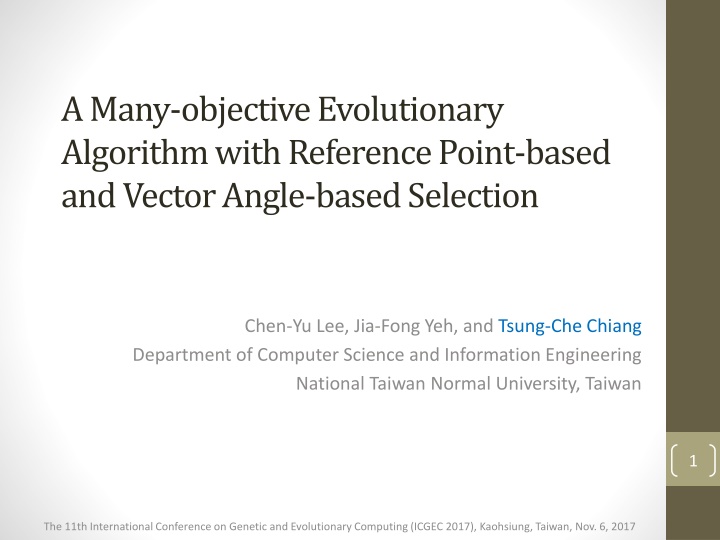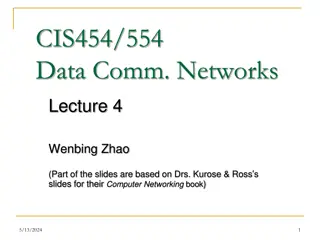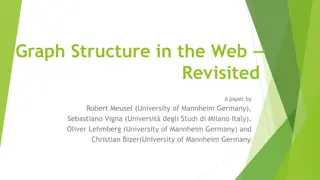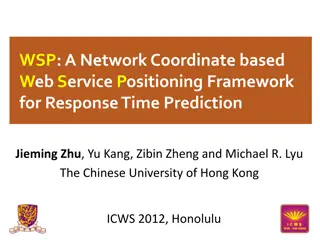
Many-Objective Evolutionary Algorithm with Reference Point-Based Selection
Explore a many-objective evolutionary algorithm with reference point-based and vector angle-based selection presented at the 11th International Conference on Genetic and Evolutionary Computing. Dive into the introduction, proposed algorithm, experiments, and conclusions of this innovative approach to multiobjective optimization problems.
Download Presentation

Please find below an Image/Link to download the presentation.
The content on the website is provided AS IS for your information and personal use only. It may not be sold, licensed, or shared on other websites without obtaining consent from the author. If you encounter any issues during the download, it is possible that the publisher has removed the file from their server.
You are allowed to download the files provided on this website for personal or commercial use, subject to the condition that they are used lawfully. All files are the property of their respective owners.
The content on the website is provided AS IS for your information and personal use only. It may not be sold, licensed, or shared on other websites without obtaining consent from the author.
E N D
Presentation Transcript
A Many-objective Evolutionary Algorithm with Reference Point-based and Vector Angle-based Selection Chen-Yu Lee, Jia-Fong Yeh, and Tsung-Che Chiang Department of Computer Science and Information Engineering National Taiwan Normal University, Taiwan 1 The 11th International Conference on Genetic and Evolutionary Computing (ICGEC 2017), Kaohsiung, Taiwan, Nov. 6, 2017
Outline Introduction Proposed Algorithm Reference point-based selection Vector angle-based selection Hybrid Experiments and Results Conclusions 2 The 11th International Conference on Genetic and Evolutionary Computing (ICGEC 2017), Kaohsiung, Taiwan, Nov. 6, 2017
Introduction Multiobjective optimization problem (MOP) Minimize (maximize) F(x) = (f1(x), , fm(x)) x: solution, x : decision space, fi: the ithobjective function Many-objective optimization problems (MaOP) refer to MOPs with more than three objectives. 3 The 11th International Conference on Genetic and Evolutionary Computing (ICGEC 2017), Kaohsiung, Taiwan, Nov. 6, 2017
dominates Introduction f2 Pareto optimal Pareto dominance (assume minimization) F(x) = (f1(x), , fm(x)) F(x) dominates F(y) iff (1) fj(x) fj(y) for all j = 1, 2, , m (2) fj(x) < fj(y) for at least one j {1, 2, , m} f1 Pareto front 4 The 11th International Conference on Genetic and Evolutionary Computing (ICGEC 2017), Kaohsiung, Taiwan, Nov. 6, 2017
Introduction The goal of solving a MOP is to find or approximate the Pareto front (PF). Convergence (as close as possible) Distribution (as even as possible) f2 f2 PF 5 f1 f1 Pink is better than green. Pink is better than green. The 11th International Conference on Genetic and Evolutionary Computing (ICGEC 2017), Kaohsiung, Taiwan, Nov. 6, 2017
Selection of Individuals NSGA-II [1] nondominated-sorting (for convergence) crowding distance (for distribution) f2 f2 f2 d(A) = d1 + d2 d1 d2 A B f1 f1 f1 (rank 2). A is better than B (since B's area is more crowded). (rank 1) is better than 6 [1] K. Deb, A. Pratap, S. Agarwal, and T. Meyarivan, A fast and elitist multiobjective genetic algorithm: NSGA-II, IEEE Transactions on Evolutionary Computation, vol. 6, no. 2, pp. 182 197, Apr. 2002. The 11th International Conference on Genetic and Evolutionary Computing (ICGEC 2017), Kaohsiung, Taiwan, Nov. 6, 2017
Reference point-based selection NSGA-III [2] controls the distribution by reference points. f3 ( 1, 0, 0) (2/3, 1/3, 0) (1/3, 1/3, 1/3) ( 0, 2/3, 1/3) ( 0, 1, 0) Reference point Individuals niche count = 1 Association niche count = 3 f2 f1 7 [2] K. Deb and H. Jain, An evolutionary many-objective optimization algorithm using reference-point based non- dominated sorting approach, part I: Solving problems with box constraints, IEEE Transactions on Evolutionary Computation, vol. 18, no. 4, pp. 577 601, 2014. The 11th International Conference on Genetic and Evolutionary Computing (ICGEC 2017), Kaohsiung, Taiwan, Nov. 6, 2017
Vector angle-based selection VaEA [3] points out that generation of reference points is a challenge. Pareto front of DTLZ1 Pareto front of DTLZ1-1 8 [3] Y. Xiang, Y. Zhou, M. Li, and Z. Chen, A vector angle-based evolutionary algorithm for unconstrained many-objective optimization, IEEE Transactions on Evolutionary Computation, vol. 21, no. 1, Feb. 2017. The 11th International Conference on Genetic and Evolutionary Computing (ICGEC 2017), Kaohsiung, Taiwan, Nov. 6, 2017
Vector angle-based selection VaEA considers distribution based on the angle between collected individuals (P) and uncollected individuals (Fl). f2 P Fl Maximum Vector Angle First: y is preferred than x and z. x a y z b c f1 9 The 11th International Conference on Genetic and Evolutionary Computing (ICGEC 2017), Kaohsiung, Taiwan, Nov. 6, 2017
NSGA-III + VaEA Hybridization NSGA-III How to select in a non-zero-member cluster (not randomly) ? Let VaEA help (based on angle). Let NSGA-III help (based on RP). VaEA How to select the initial members for reference ? 10 The 11th International Conference on Genetic and Evolutionary Computing (ICGEC 2017), Kaohsiung, Taiwan, Nov. 6, 2017
Experiments and Results Benchmark functions The negative version of DTLZ1-4 [4][5] Number of objectives: 3, 5, 8, 10 Tested algorithms NSGA-III VaEA Improved NSGA-III (I-NSGA-III) [4] H. Ishibuchi, Y. Setoguchi, H. Masuda, and Y. Nojima, Performance of decomposition-based many-objective algorithms strongly depends on pareto front shapes, IEEE Transactions on Evolutionary Computation, vol. 21, no. 2, pp. 169 190, Apr. 2017. [5] K. Deb, L. Thiele, M. Laumanns, and E. Zitzler, Scalable test problems for evolutionary multi-objective optimization, in Evolutionary MultiobjectiveOptimization, A. Abraham, L. Jain, and R. Goldberg, Eds. London, U.K.: Springer-Verlag, 2005, pp. 105 145. 11 The 11th International Conference on Genetic and Evolutionary Computing (ICGEC 2017), Kaohsiung, Taiwan, Nov. 6, 2017
Experiments and Results Performance measure: Inverted generational distance (IGD) f2 Pareto front Approximation f1 Parameter setting is the same as NSGA-III and VaEA. The population size and generation number depend on the DTLZ function and objective number. 20 independent runs 12 The 11th International Conference on Genetic and Evolutionary Computing (ICGEC 2017), Kaohsiung, Taiwan, Nov. 6, 2017
Experiments and Results Plot of obtained solutions in one run for DTLZ2-1with M = 3 VaEA NSGA-III 13 I-NSGA-III The 11th International Conference on Genetic and Evolutionary Computing (ICGEC 2017), Kaohsiung, Taiwan, Nov. 6, 2017
Experiments and Results Value path plot of obtained solutions in one run for DTLZ2-1with M = 10 objective value objective value NSGA-III VaEA objective number objective number objective value 14 I-NSGA-III The 11th International Conference on Genetic and Evolutionary Computing (ICGEC 2017), Kaohsiung, Taiwan, Nov. 6, 2017
Conclusions This paper addressed the selection procedure in many- objective evolutionary algorithms. The selection procedures in NSGA-III and VaEA are studied, and a hybrid method was proposed. Experimental results showed that the proposed I-NSGA- III outperformed the NSGA-III and is competitive to VaEA. Besides, I-NSGA-III can expand the front better than NSGA-III and VaEA. How to keep good distribution and extreme solutions simultaneously is the next topic to study. 15 The 11th International Conference on Genetic and Evolutionary Computing (ICGEC 2017), Kaohsiung, Taiwan, Nov. 6, 2017
Thank you for listening. 16 The 11th International Conference on Genetic and Evolutionary Computing (ICGEC 2017), Kaohsiung, Taiwan, Nov. 6, 2017






















